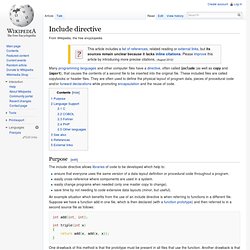

Emotiv EPOC 14-electrode EEG headset to control a Rovio robot - OpenDefense - by IdeaScale. The article describes using an EEG headset to control a robot remotely over Skype using triggering a reading on the EEG with your mind, facial gestures and head movements.

It is similar to a motion capture suit but used for your head instead of body. Used together with a motion capture suit using similar technology (accelerometers and gyros), you could use it to operate a robot with limbs remotely. Used by itself, the EEG headset could be used to control a UAV with head movements. "April 26, 2010 - By Robert Oschler Programming Your Own Thought-Controlled Robot A couple of months ago I examined the Emotiv EPOC 14-electrode EEG headset, which lets you control computers and video games with your thoughts rather than your hands.
I decided to see if I could use the headset to control a WowWee Rovio robot using just my mind and facial gestures. I started with a program I wrote called Robodance, which already worked as a control program for the Rovio. "Conclusion and Video. Playing the Emotiv EPOC" Whenever you're frustrated, your mind emits a particular pattern of brain waves.

And while the pattern might stay consistent, it's probably a little different from the pattern another person emits whenever he or she gets frustrated. Because all brains are unique, the Emotiv EPOC has to get to know your brain before you can get your Luke Skywalker on. First, as you're putting on the headset, you need to finagle the electrodes to make appropriate contact with your head. Because it doesn't use the adhesive material of medical electroencephalogram (EEG) machines and the headset is meant to fit all sizes, you need to arrange the electrodes manually until they're just right. Refrain from making jerky movements to avoid disconnecting an electrode. A few of the actions the game asks you to practice and perform are: Lifting an objectDropping an objectPushing an objectMaking an object vanishRotating an object on six axes Some emotions it reads are: Emotiv EPOC. Emotiv EPOC + Processing/Arduino.
WGM 35. EEG Control (I) - LOTO - Confluence. FBLR Mind-Controlled Robot. Related articles: Processing + EPOC via OSC | EPOC-to-Arduino “Goodbye, World” | Arduino + fischertechnik | BYTR Virtual Servitor FBLR (“Fibbler”) is a robot that moves forward and backward, and turns left and right, in response to its operator’s thoughts.

The signal flow is brain → Emotiv EPOC → Mind Your OSCs → Processing → Arduino → fischertechnik robot. I wrote a Processing sketch ( zipped with data files ) that converts the EPOC signals via OSC messages, to Arduino signals that move the robot. The sketch uses the arduino , controlP5 , and oscP5 libraries. The Arduino uses Firmata (standard with the Arduino software) and a motor shield from Rugged Circuits (see this article for more info). Downloads - text20 - The Text 2.0 Framework. Eye Tracking in HTML and Java. Convert existing C++ (.h and .cpp) files to java for Android. Header file. Purpose[edit] ensure that everyone uses the same version of a data layout definition or procedural code throughout a program.easily cross-reference where components are used in a system.easily change programs when needed (only one master copy to change).save time by not needing to code extensive data layouts (minor, but useful).

An example situation which benefits from the use of an include directive is when referring to functions in a different file. Suppose we have a function add in one file, which is then declared (with a function prototype) and then referred to in a second source file as follows: lectures on BCI First Thought Controlled Game "Think-Tac-Toe" by Jedi Mind, Inc. For Emotive EPOC Neuroheadset.